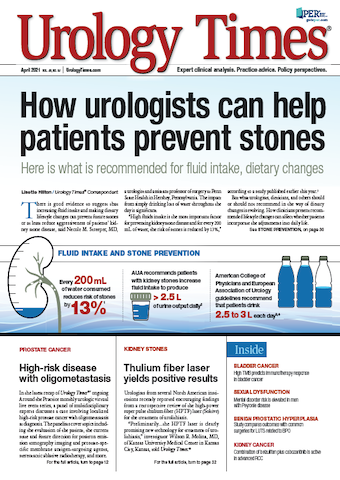Publication
Article
Urology Times Journal
Bipolar Androgen Therapy sensitizes CRPC to subsequent antiandrogen therapy
Author(s):
“The most important finding is that post-abiraterone, [bipolar androgen therapy] can markedly improve the magnitude and duration of response to enzalutamide,” the authors wrote.
Bipolar androgen therapy (BAT) demonstrated “meaningful clinically activity” and showed the capacity to sensitize castration-resistant prostate cancer (CRPC) to subsequent antiandrogen therapy, according to findings from the phase 2 TRANSFORMER trial published in the Journal of Clinical Oncology.1
The TRANSFORMER trial (NCT02286921) randomized asymptomatic patients with metastatic CRPC and disease progression on abiraterone acetate (Zytiga) to BAT or the antiandrogen therapy enzalutamide (Xtandi). The trial missed its primary end point, as BAT did not show superior clinical or radiographic progression-free survival (PFS) compared with enzalutamide; however, although the study was not powered to show equivalency, the results showed similar outcomes between the treatments in terms of median PFS (5.7 months in both groups), time to PSA progression (2.8 months for BAT vs 3.8 months for enzalutamide), and the rate of patients with a 50% decline in PSA (PSA50; 28.2% vs 25.5%, respectively).
Further, crossover to the opposite arm was allowed at progression, and the PSA-PFS (interval from randomization to the time of PSA progression) for enzalutamide increased from 3.8 months following abiraterone to 10.9 months following BAT (HR, 0.45; P = .008). The PFS2 (PFS from randomization through crossover) was 28.2 versus 19.6 months for those who crossed from BAT to enzalutamide versus those crossing from enzalutamide to BAT, respectively (HR, 0.44; P = .02). The median overall survival (OS) was 37.1 months versus 30.2 months, respectively (HR, 0.68; P = .225). The PSA50 was 77.8% versus 23.4%, respectively.
Safety data showed that the majority of adverse events related to BAT were grade 1/2. The investigators also reported that patient-reported QoL data consistently favored BAT over enzalutamide.
“Although the trial failed to demonstrate superior PFS with BAT over enzalutamide in post-abiraterone CRPC, it demonstrated that BAT is safe, enhances QoL, and has efficacy comparable to enzalutamide in this patient population. However, the most important finding is that post-abiraterone, BAT can markedly improve the magnitude and duration of response to enzalutamide when used as an intervening therapy,” the authors wrote.
BAT involves “periodical oscillation between castration levels and supraphysiological levels of testosterone in order to prevent the adaptation of prostate cancer cells to a low-androgen environment.”2
Between April 2015 and April 2018, the open-label TRANSFORMER trial randomized 195 patients in a 1:1 ratio to BAT (n = 94) or enzalutamide (n = 101). Across the overall study population, the median age was 71, 87% of patients were White, about 81% of patients had received abiraterone for >6 months, about 90% of patients had a Gleason score ≥7, and the median number of metastases was 2. The mean PSA at baseline was 44.3 ng/mL in the BAT arm and 50.6 ng/mL in the enzalutamide arm.
At a median follow-up of 31.9 months, the median PFS was 5.7 months for both arms (HR, 1.14; P = .42). The median OS was 32.9 months with BAT versus 29 months with enzalutamide (HR, 0.95; P = .80).
“These results support further evaluation of sequential BAT [followed by] enzalutamide as a single therapy. Further study is warranted to define the potential for sequential treatment to produce significant survival improvement in men with CRPC,” the author wrote in their conclusion.
References
1. Denmeade SR; Wang, H; Agarwal N, et al. TRANSFORMER: A randomized phase II study comparing bipolar androgen therapy versus enzalutamide in asymptomatic men with castration-resistant metastatic prostate cancer [published online February 22, 2021]. J Clin Oncol. doi: 10.1200/JCO.20.02759
2. Leone G, Buttigliero C, Pisano C, et al. Bipolar androgen therapy in prostate cancer: Current evidences and future perspectives. Crit Rev Oncol Hematol. 2020;152:102994. doi: 10.1016/j.critrevonc.2020.102994































